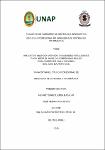| dc.contributor.advisor | Reátegui Pezo, Alejandro | |
| dc.contributor.author | Erda Bazalar, Mehmet Suheyl | |
| dc.contributor.author | Venancino Hoyos, José | |
| dc.date.accessioned | 2024-01-11T17:06:41Z | |
| dc.date.available | 2024-01-11T17:06:41Z | |
| dc.date.issued | 2023 | |
| dc.identifier.other | 005.3 E72 2023 | |
| dc.identifier.uri | https://hdl.handle.net/20.500.12737/9684 | |
| dc.description.abstract | The objective of this work was to determine to what extent the implementation of an Android application supported by business intelligence manages to measure the level of aggressiveness in the residents of Villa Disnarda in the district of San Juan Bautista 2021. According to the researcher's purpose, it is applied, According to the number of measurements, it is transversal, the sample universe was made up of 50 people who attended the test, the information was collected on an observation sheet, when the residents used and did not use the application, it was applied to all the processes that They involve the dependent variable, that is, effectiveness in the registration of user data, in the registration of the test and in the generation of diagnosis. The results were: in the data recording, using the application, 100% recorded correctly; When they did not use it, 58% correctly recorded their data manually and 42% did not do it correctly. The time in seconds of recording the test, using the application, 100% register the test, placing themselves in the very fast category, by not using the application, 44% register the test and are placed in the delay category, and 56 % records the test and is placed in the too late category. The time to generate a diagnosis, using the application, 100% is located in the very fast category, without using the application, 100% is located in the category that takes too long. In conclusion, the Android application supported by business intelligence is 100% effective in measuring the level of aggressiveness. | en_US |
| dc.description.abstract | El objetivo de este trabajo fue determinar en qué medida la implementación de un aplicativo Android apoyado en business intelligence, logra medir el nivel de agresividad en los pobladores de Villa Disnarda del distrito de San Juan Bautista 2021., según el propósito del investigador es aplicado, según el número de mediciones es transversal, el universo muestral estuvo constituido por 50 personas que acudieron al test, la recolección de información se hizo en una ficha de observación, cuando los pobladores usaban y no usaban el aplicativo, se aplicó a todos los procesos que involucran la variable dependiente, es decir, efectividad en el registro de datos del usuario, en el registro del test y en la generación de diagnóstico. Los resultados fueron: en el registro de datos, usando el aplicativo, el 100% registró correctamente; cuando no lo usaban, el 58%, registra correctamente sus datos manualmente y 42% no lo hacen correctamente. El tiempo en segundos de registro del test, usando el aplicativo el 100% registra el test, ubicándose en categoría de muy rápido, al no usar el aplicativo el 44%, registra el test y se ubica en la categoría de demora, y el 56% registra el test y se ubica en categoría de demora demasiado. El tiempo para generar diagnóstico, usando aplicativo el 100% se ubica en la categoría de muy rápido, sin usar el aplicativo, el 100% se ubica en la categoría demora demasiado. En conclusión, el aplicativo Android apoyado en business intelligence es efectivo al 100% en la medición del nivel de agresividad. | es_PE |
| dc.format | application/pdf | es_PE |
| dc.language.iso | spa | es_PE |
| dc.publisher | Universidad Nacional de la Amazonía Peruana | es_PE |
| dc.rights | info:eu-repo/semantics/openAccess | * |
| dc.rights.uri | https://creativecommons.org/licenses/by/4.0/ | * |
| dc.subject | Aplicaciones para móviles | es_PE |
| dc.subject | Agresividad | es_PE |
| dc.subject | Ensayo | es_PE |
| dc.subject | Tests | es_PE |
| dc.subject | Población urbana | es_PE |
| dc.title | Aplicativo android apoyado en business intelligence para medir el nivel de agresividad en los pobladores de Villa Disnarda San Juan Bautista 2021 | es_PE |
| dc.type | info:eu-repo/semantics/bachelorThesis | es_PE |
| thesis.degree.discipline | Ingeniería de Sistemas e Informática | es_PE |
| thesis.degree.grantor | Universidad Nacional de la Amazonía Peruana. Facultad de Ingeniería de Sistemas e Informática | es_PE |
| thesis.degree.name | Ingeniero(a) de Sistemas e Informática | es_PE |
| dc.subject.ocde | https://purl.org/pe-repo/ocde/ford#2.02.04 | es_PE |
| renati.author.dni | 72937820 | |
| renati.author.dni | 43066182 | |
| renati.advisor.orcid | https://orcid.org/0000-0003-3901-7240 | |
| renati.advisor.dni | 06182363 | |
| renati.type | https://purl.org/pe-repo/renati/type#tesis | es_PE |
| renati.discipline | 612156 | es_PE |
| renati.level | https://purl.org/pe-repo/renati/level#tituloProfesional | es_PE |
| renati.juror | Tuesta Moreno, Manuel | |
| renati.juror | Vilca Barbaran, Rafael | |
| renati.juror | Ruiz Hidalgo, Francisco Miguel | |
| dc.publisher.country | PE | es_PE |





